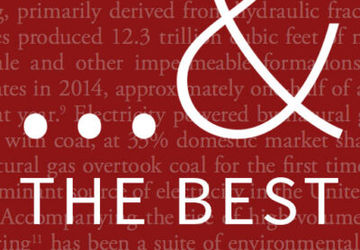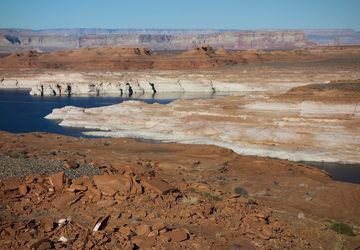A Symphony of Image and Sound: Lukas Felzmann Presents His Photographic Vision

By Sasha Landauer
The term “apophenia” was coined by the German psychiatrist Klaus Conrad in 1958 as a way to describe people’s urge to find relationships between unrelated items. Although this was initially considered a disorder, the photographer and conceptual artist Lukas Felzmann suggests that this tendency is also a source of human creativity.
Speaking at the McMurtry Arts Building at Stanford on October 29 to mark the start of the 2018-19 ArtsWest program year, Felzmann opened with a series of images from his first book of photographs, Landfall. He said that as you open his book “there is no text explaining what you are supposed to think or what the work is about; it just jumps into a sequence of images.”
Felzmann set the images to music, playing a Shostakovich piano concerto as he advanced through his photographs at chosen intervals. Like many live performances, he said, “it won’t always be the same.”
As Felzmann lingered briefly on each image, there was no time for viewers to form a logical sequence; instead Felzmann left the impression of a tenuous relationship between the viewer and the land. The photos passed rapidly—leaving fleeting impressions of shock and beauty.

A pile of rotting books slope gently against a window; dirt and pine needles on a microscope; root systems blinded by light above; receding boulders;

a window surrounded by a cracked wall reveals a farm; a stack of elegant chairs inside an abandoned house;

a swarm of birds, densities dispersed; buttons of a floral mattress filled with dirt; a uniform flock of birds, wings closed.
Although some photos were clearly related, like the bird swarms, others inspired bouts of apophenia with their hints of similarity. The mind raced to form patterns among the sequential photographs and the background music.
Felzmann progressed rapidly through these scenes, occasionally pausing, with no uniform motion. According to Felzmann, Landfall itself was created to deliberately facilitate intimacy, “Big, splashy photo books are great, but you tend not to interact with them as much,” he said. “I wanted one you could hold in your hand, interact with, curl up with.”
Conjuring Emotion in a Torrent of Images

By moving through the photographs rapidly to the backdrop of music, Felzmann gave the audience the opportunity to connect with the images emotionally, rather than rationally. This emotional relationship to the land extended to his next book, Waters In Between, based around images from the Sacramento Valley. This area is an ancient floodplain, without which California might not exist as we know it. “Interestingly, it still floods. It is a floodplain, but now when it floods we call it a ‘disaster,’” Felzmann said, “I started musing about this, how language represents our relationship to the land.”
By immersing the audience in photographs, Felzmann replaces the language that bridges individuals and nature with primal symbolism. “Not just the blackbirds,” he said, describing his studies of vast bird flocks, “but this whole system seemed like floating hieroglyphs of a language we don’t understand, but we somehow know, internally.”
The bird swarm photographs throughout the collection aptly communicate a deeper intrinsic language. In some images, the swarm appears perfectly uniform—contained between parallel power lines or adhering to the contour of the mountains. In other photographs, the swarm seems like a declaration of individualism, as each bird appears to be in a different state of unfurling its wings.
“Sometimes I tried to be inside the flock, forget about the borders of the system, forget about the margins,” Felzmann said. “There is something very deep that you feel when you watch these flocks, when they are close by.”
The exploration of the swarm extended to questions of scale. “It is a spectacular version of collective behavior. As a matter of fact this goes on in your body, cells might behave this way,” he said. “There is something almost biblical in it.”
The Places ‘In Between”

Felzmann categorized the Central Valley as a kind of in-between place. “We cross it going east and north, south, and west, going to the mountains, going to the desert, going to LA,” he said. “Every place is interesting to me as an artist but also to me as a person. Every place needs our attention.”
By settling in the Central Valley, Felzmann captured the power of small details within an open, empty space. These photographs favored landscapes over people, he said. “I’m interested in what we do, what we leave behind, our traces.”
The texture and physicality of the land comes through in the photographs. “I think of photographing as a very sculptural activity,” Felzmann said. “Being out in the world and compressing those three dimensions into two dimensions is a sculptural activity.” He added that time constitutes a fourth dimension to capture as well.
This sculptural process is also reflected in Felzmann’s choice of equipment. “The camera I use is a view camera, a simple archaic glass plate on one side, lens on the other, bellows in the middle,” he said. When printing, he adds, “you have to go into a dark space to make a negative into a positive. It’s a sculpture with light. The sculpture is not perfect because projections are inherently difficult.”
For example, Felzmann said, when using a photographic enlarger, the center of the projected image is slightly farther than the edges of the negative, resulting in faintly blurred borders. “To an inkjet printer, it makes no difference if a dot is in the center or the edge. It’s not so interesting because the prints are kind of flat,” Felzmann said. By contrast, chemical photo prints “mirror our vision,” in their center-weighted focus.
Decisions made while manipulating the camera are a significant element of the artistic process, said Felzmann. “I want challenging, I want involved, I want serene, I want to be absorbed and struggle,” he declared. “The work becomes kind of grim and humorous and bizarre, not just beautiful.”

This intensity comes through in Waters In Between— whose photographic plates include a dead coyote mounted on a fence; the interior of an abandoned schoolhouse with a peeling blackboard; shoes hung along the side of a road; brightly colored beehives; fish in a puddle in the middle of a road, swallows’ nests beneath a bridge forming a roman column; workers’ gloves abandoned in the dirt.
The lack of human figures in the photos lends them an ethereal quality, as though we are trespassing on a long-gone civilization. “I photograph what people leave behind, not who they are,” Felzmann said. “Photography deals with ghosts, but it also deals with piles—things that have been left—strata of something.”
Felzmann takes glimpses of these ghostly landscapes and fixes them in the material world within his sculpturally-inspired artistic process. “Photography is an optical phenomenon—it’s a darkroom with a hole. Even in your head, and in your eyes, you have a little camera obscura,” he said, describing a pinhole aperture that projects an inverted image of the view outside onto the walls of a room. “When they talk about the invention of photography,” he says, “they really talk about the ability to fix the image chemically.”
Books as Physical Objects, Not Mere Collections of Images
“Making books is a really important part of my work. I don’t just see them as reproductions of photographs, I see them as original sculptures or original pieces of work that are made for you to interact with, to read through in real time.”
Felzmann’s latest book, Apophenia, was inspired by sorting through his father’s postcards upon his death. The dichotomy of the images and individualized handwriting prompted him to weave together vertical images of his own that didn’t fit in the narrative of prior books.
“Somehow combining these two archives to weave them together kind of like a musical; a fugue or something where you have a scene that reverses itself and plays upon itself as the music progresses,” he said. “It’s up to you to create those connections and bring your own Apophenia to the book.”
Teaching and Working at Stanford
As part of his work with the Bill Lane Center, Lukas Felzmann will be offering a course that explores photography in the American West. For more information, see our American West Course listings.
Related
Conceptual Artist and Photographer Lukas Felzmann Joins the Center
ArtsWest Initiative, Bill Lane Center for the American West, Stanford University


